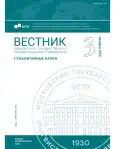Standardizing Minority Languages: Conflict between Traditional and New Speakers
- 作者: Guermanova N.N.1
-
隶属关系:
- Moscow State Linguistic University
- 期: 编号 3(884) (2024)
- 页面: 25-32
- 栏目: Linguistics
- URL: https://journal-vniispk.ru/2542-2197/article/view/316132
- ID: 316132
如何引用文章
全文:
详细
The article focuses on the conflict between traditional speakers of minority languages and new speakers, who learned the language in its standardized form in the course of revitalization. The author reveals the social, psychological and linguistic aspects of this conflict. It is shown, with a special reference to Manx Gaelic, that both sides of the conflict take a purist stand; however, for the former it means following traditional linguistic practices, while for the latter - innovations with a view to return to historical roots.
作者简介
Natalia Guermanova
Moscow State Linguistic University
编辑信件的主要联系方式.
Email: nata-germanova@yandex.ru
Doctor of Philology (Dr. habil.), Associate Professor, Professor at the Department of General and Comparative Linguistics Moscow State Linguistic University
俄罗斯联邦参考
- Guermanova, N. N. (2021). Language standardization and linguistic conflictology. Vestnik of Moscow State Linguistic University. Humanities, 9(851), 11–22. (In Russ.)
- Arkhipova, L. S. (2019). Standardization of a minority language as a means of increasing its ethnolinguistic vitality. Vestnik of Moscow State Linguistic University. Humanities, 3(819), 11–21. (In Russ.)
- Grinevald, C., Bert, M. (2011). Speakers and communities. In The Cambridge Handbook of Endangered Languages (pp. 45–65). Cambridge: Cambridge University Press.
- Ó Murchadha, N. P., Hornsby, M., Smith-Christmas, C., Moriarty, M. (2018). New Speakers, Familiar Concepts? In New Speakers of Minority Languages: Linguistic Ideologies and Practices (pp. 1–22). London: Palgrave Macmillan.
- Costa, J. (2015). New speakers, new language: on being a legitimate speaker of a minority language in Provence. International Journal of the Sociology of Language, 231, 127–145.
- Guermanova, N. N. (2023). Arisen like phoenix: revitalisation of the Manx language. Bulletin of the Moscow Region State University. Series Linguistics, 3, 18–26. (In Russ.)
- Ó hIfearnáin, Т. (2015). Sociolinguistic vitality of Manx after extreme language shift: authenticity without traditional native speaker. International Journal of the Sociology of Language, 231, 45–62.
- Cheek, C., Nicol, S., Grainger, S. (2011). Manx identity and Comeovers. In Islands and Britishness: A Global Perspective (рр. 65–77). Cambridge: Cambridge Scholars Publishing.
- Lewin, Ch. (2022). Continuity and hybridity in language revival: The case of Manx. Language in Society, 51(4), 663–691. doi: 10.1017/S0047404521000580
- Lewin, Ch. (2017a). Scholarship and language revival: language ideologies in corpus development for revived Manx. Studia Celtica Posnaniensia, 2(1), 97–118. doi: 10.1515/scp-2017-0006
- Lewin, Ch. (2017b). ‘Manx hardly deserved to live’: Perspectives on language contact and language shift. Zeitschrift für celtische Philologie, 64, 1–70.
- Stowell, B. (2005). The case of Manx Gaelic. In Rebuilding the Celtic languages: Reversing language shift in the Celtic countries (pp. 383–416). Talybont: Y Lolfa.
- O’Rahilly, T. F. (1932). Irish dialects past and present, with chapters on Scottish and Manx. Dublin: Browne & Nolan.
- Broderick, G. (1999). Language Death in the Isle of Man: An investigation into the decline and extinction of Manx Gaelic as a community language in the Isle of Man. Tubingen: Niemeyer.
- McLeod, W. (2008). Linguistic Pan-Gaelicism: A dog that wouldn’t hunt. Journal of Celtic Linguistics, 12(1), 87–120.
- Broderick, G. (2013). Neologisms in revived Manx in the Isle of Man. Studia Celtica Fennica, 10, 7–29.
补充文件










